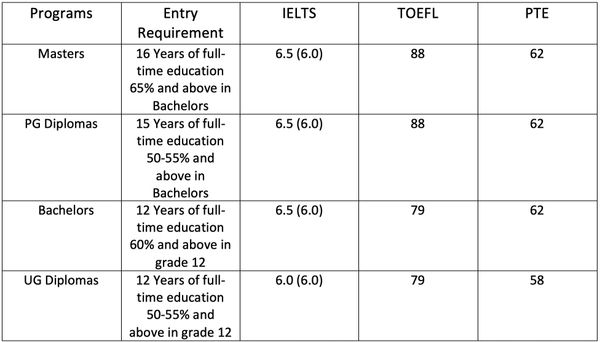Study in Canada
About Canada
PNP – Provincial Nominee Program
Why Study in CANADA?
- Canada, with a landmass of 99 lakh square kilometres and a population of about 36 million, is the second-largest country in the world.
- Society & Culture
- The country of immigrants.
- Society that is diverse.
- One of the world's most industrialized nations.
- While eastern Canada is recognized for its agriculture, forestry, and fishery, northern Canada is known for its gas and oil exploration.
- Ontario and Quebec are well renowned for their industries.
- A pioneer in biotechnology, pharmaceuticals, telecommunication, and aerospace.
- Nearly 80% of Canadians reside within 250 km of the U.S. border.
- Why Study in CANADA?
- Qualifications are appreciated all around the world.
Why Study in CANADA?
PNP – Provincial Nominee Program
Why Study in CANADA?
- Qualifications are appreciated all around the world.
- Cost-effective education.
- Culturally diverse society.
- Communities that are safe and sound.
- Possibility of receiving pay while interning.
- After graduation, there are excellent career options and post-study work authorization.
- Possibility of settling permanently
PNP – Provincial Nominee Program
PNP – Provincial Nominee Program
PNP – Provincial Nominee Program
An essential fast-track route to Canadian permanent residency is through provincial nomination. For instance, if a student completes a course at any school in Saskatchewan, he may be eligible to apply for permanent residence through the Provincial Nominee Program afterward if the province is still a participant at that time. The provinces that occasionally take part in the Provincial Nominee Program (PNP) include Ontario, Alberta, British Columbia, Manitoba, New Brunswick, Newfoundland and Labrador, Northwest Territories, Nova Scotia, Prince Edward Island, Saskatchewan, and Yukon.
Parents are given access to the Super Visa facility.
The Super Visa is a temporary residence visa that enables parents and grandparents of Canadian citizens or permanent residents to stay in the country for up to two years at a time. It is good for a maximum of ten years. The duration of a standard multiple-entry visa is likewise up to ten years.
Education System in Canada
Education System in Canada
PNP – Provincial Nominee Program
Canada invests a lot of money in its educational system. According to the Organization for Economic Co-operation and Development (OECD), Canada is among the top education performance in the world and is in the top three nations in terms of expenditure on public post-secondary education per capita.
How it works
Education System in Canada
Academic Year
The post-secondary education system in Canada is divided into:
- Certificate level, generally for a year.
- Diploma level, for one or two years.
- Advanced diploma, generally two or three-year programs.
- Bachelor degrees, awarded after four years of full-time study.
- Postgraduate diplomas/certificates, for one or two years of study.
- Master’s degrees, available after a bachelor degree to excel in a certain subject, for one to two years.
- Doctorate or PhD, generally four to seven years.
Academic Year
Education System in Canada
Academic Year
From the beginning of September to the end of April or the beginning of May, the majority of colleges and universities normally offer classes. Typically, the winter session is split into two terms that run from September through December and then again from January through April. Between May and August, a variety of summer study options are available. A select few schools in Canada also provide year-round education. Undergraduate degrees can be earned in three or four years, depending on the university. Postgraduate degrees can be earned in one to two years, depending on the kind. In general, master's programs last one to two years, but PhD programs are lengthier than in other nations. They typically take four to seven years to finish.
Teaching and learning style
Teaching and learning style
Teaching and learning style
Canadian universities are committed to research and excellent instruction, but they also want to give their students opportunity to succeed in school, in the workplace, and in life. Lectures and tutorials are both used in university courses. Professors provide lectures to groups of between 30 and 200 students. They typically include a related element, such a lab or a lesson. A tutorial or lab enables a more thorough discussion of course material. Typically, tutorial classes include between 20 and 30 students.
Scholarships
Teaching and learning style
Teaching and learning style
Some universities and colleges in Canada give scholarships and prizes to foreign students who do very well. The available funding and award types differ amongst the various institutions. It's difficult to get a scholarship, and you often have to apply directly to the institution that grants it.
Working In Canada
Teaching and learning style
Co-op & Internship Programmes
Students are eligible to work part time on or off campus from day one. Study permits will automatically authorize the holder to work on/off-campus for more than 20 hours per week during the academic session and full-time (i.e. 40 hours per week) during scheduled breaks without the need to apply for a separate work permit.
Co-op & Internship Programmes
Co-op & Internship Programmes
Co-op & Internship Programmes
Many of the programs have inbuilt internships of one or two semesters which provide an opportunity for the student to get first hand exposure and experience in Industry relating to his or her area of study.
Key Features
Co-op & Internship Programmes
Key Features
- Free Comprehensive Career Counselling
- Profile Building
- Visa Counselling
- Scholarships, Education Loans and Financial Aid Consulting
- Accommodation Assistance
- Travelling Assistance

Top Ranked University

Academic & English Language Requirements
The Overseas Consultant - TOC
705/D, Crystal Plaza, Link Road, Veera Desai Industrial Estate, Andheri West, Mumbai, Maharashtra 400053, India
Copyright © 2024 The Overseas Consultant - TOC - All Rights Reserved.
Designed by Whyte Wings Media
This website uses cookies.
We use cookies to analyze website traffic and optimize your website experience. By accepting our use of cookies, your data will be aggregated with all other user data.